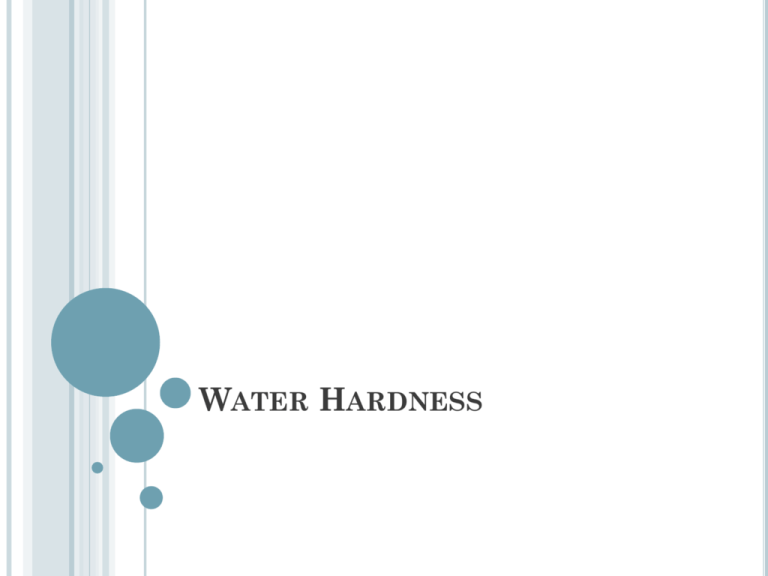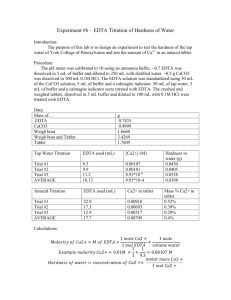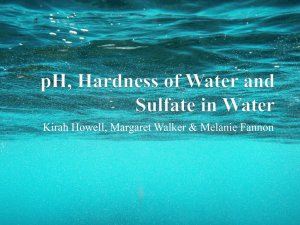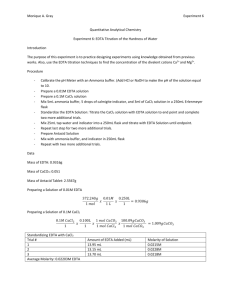Water Hardness: Causes, Analysis & Determination Methods
advertisement

WATER HARDNESS WATER HARDNESS Definition Concerns Scaling Cleaning Public Health CAUSES Cations causing hardness Ca2+ Mg2+ Sr2+ Fe2+ Mn2+ Anions HCO3SO42ClNOSiO32- Table 19.1. Principle cations causing hardness in water and the major anions associated with them SOURCES From USGS WATER HARDNESS RATING mg/L as CaCO3 Degree of Hardness 0-60 Soft water 61-120 Moderately hard water 121-180 Hard water >180 Very hard water From USGS METHODS OF DETERMINATION 1. Complete Cation Analysis Most accurate Calculation of the hardness caused by each ion is performed by use of the general formula: Hardness (mg/L) as CaCO3 = M2+ (mg/L) X 50 EW of M2+ where M2+ represents any divalent metallic ion and EW represents equivalent weight EXAMPLE OF COMPLETE CATION ANALYSIS Calculate the hardness of a water sample with the following analysis: Cation Concentration (mg/L) Anion Concentration (mg/L) Na+ 20 Cl- 40 Ca2+ 15 SO42- 16 Mg2+ 10 NO3- 1 Sr2+ 2 Alkalinity 50 EXAMPLE OF COMPLETE CATION ANALYSIS Cation EW Hardness, mg/L as CaCO3 Ca2+ 20.0 (15)(50)/(20.0) = 37.5 Mg2+ 12.2 (10)(50)/(12.2) = 41.0 Sr2+ 43.8 (2)(50)/(43.8) = 2.3 Total hardness = 80.8 METHODS OF ANALYSIS 2. Titrimetric Method Burette A piece of glassware designed to deliver known amounts of liquid into another container EDTA Ethylenediaminetetracetic acid Chelating agent Substance whose molecules can form several bonds to a single metal ion Multi-dentate ligands Many clawed; holding onto the metal ion to form a very stable complex 4-6 bonds EBT Eriochrome Black Indicator A WORD ABOUT MOLES A mole used in chemistry is something like the term ‘dozen’ we use every day. The atomic weight of any element, expressed in grams, contains 6.02 x 1023 atoms. There are 6.02 x 1023 atoms of oxygen in 16 g of oxygen There are 6.02 x 1023 atoms of hydrogen in 1 g of hydrogen A mole simply means that you have 6.02 x 1023 of whatever you’re talking about Avogadro’s number MOLARITY Defined as the number of moles of solute divided by the number of liters of solution Molarity (mol/L; M) = moles of solute liters of solution The molar concentration of EDTA in this experiment is 0.005 mol/L. EXAMPLE OF EDTA CALCULATION 50.0 mL tap water sample 13.75 mL EDTA used in the titration a) b) c) Calculate the moles of EDTA used. Calculate the molarity of metal ion present in the tap water sample (Remember: EDTA binds to metal ions on a 1:1 molar ratio). Find the ppm calcium ion concentration in the sample based on your results from question b). EXAMPLE OF EDTA CALCULATION a) Calculate the moles of EDTA used Molarity of EDTA = 0.005 mol/L Moles of EDTA = (Molarity)(Liters of EDTA used) EXAMPLE OF EDTA CALCULATION a) Calculate the molarity of metal ion present (Remember EDTA binds to metal ions on a 1:1 ratio) Molarity of metal ion = moles of EDTA liters of water sample EXAMPLE OF EDTA CALCULATION Calculate concentration of CaCO3 in ppm CaCO3 (ppm) = (Molarity of metal ion)(FW of Ca2+)(1000 mg/g) CaCO3 (ppm) =






